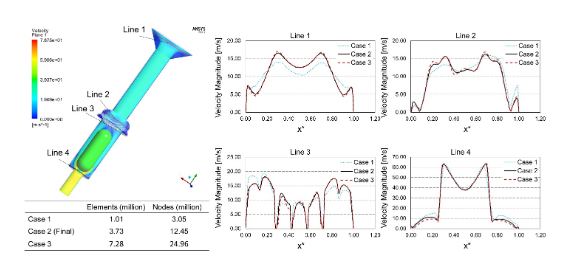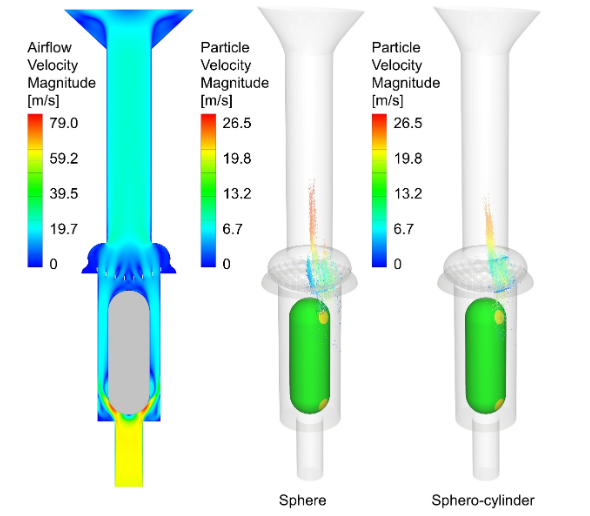
Simulation shows how to limit the spread of coronavirus and aids in the investigation of respiratory diseases
In the race to combat the global pandemic of COVID-19, medicine has used simulation technology to accelerate research development and assist in the production of hospital equipment essential for treating the disease. The tool has supported health professionals, policy makers, and the global community in tackling the health crisis.
Through the software, it has been possible to model inhalers, scale the production of protective masks, and even calculate social living measures that limit the spread of the coronavirus.
Simulation to calculate social distancing
In the current pandemic scenario, it is important to limit the spread of the virus and the main measure adopted by nations is social isolation. Ansys software is able to simulate everyday situations to provide exact distances that one person should keep from another during a conversation, in supermarket queues, or when exercising, for example.
Simulation for the correct use of protective masks
Masks can reduce the risk of contaminating other people by as much as six times. Another feature of the software is to pinpoint the adjustments needed to ensure that the masks are sealed properly and can reduce the risk of possible exposure.
Simulation for environment disinfection
In today’s highly contagious environment, it is extremely important to minimize the risks for physicians and healthcare workers who care for COVID-19 positive patients. Negative pressure rooms (NPRs) can help reduce healthcare staff exposure to the virus while serving patients. The simulation demonstrates different room designs of NPRs and allows teams to optimize room design, ventilation inlet placement, and blower capacity to prevent oral and nasal particles from circulating in the environment.
Rocky helps model inhalers for the treatment of respiratory diseases
Even before the emergence of SARS-CoV-2, respiratory diseases represented one of the leading causes of global mortality – as well as a heavy financial burden on healthcare systems. Experimental studies in this field are fraught with difficulties and expense, which makes simulation an attractive tool because it delivers fast and accurate results, both in testing and modeling equipment.
The engineering school at the University of Oklahoma in the United States has been conducting research since last year using Ansys and Rocky software to understand the transport of fine particles in human airways and to model inhalers. The article by Jianan Zhao and Yu Feng of the School of Chemical Engineering at the University of Oklahoma presents how Rocky has been used to study the transportation of drug particles in dry powder inhalers.
Pulmonary drug delivery devices, such as dry powder inhalers (DPIs), have been widely used to deliver an effective dose of active pharmaceutical ingredients (APIs) into the target respiratory system. Rocky DEM’s multiphysics simulation provides significant value for optimizing DPI design as well as demonstrating bioequivalence (BE) of generic DPI products, as the software has the ability to describe the physical and chemical mechanisms underlying drug transport and interactions in a non-invasive manner. Compared to in vitro testing, numerical simulation is less costly and time consuming, while providing accurate results to reduce the length of the research and development cycle for DPI product innovations.
During release and emission within DPIs, particle-particle interaction forces, i.e. van der Waals and electrostatic forces, play a vital role in the transport of drug particles and determine the aerodynamic size distribution of the inlet in the human mouth. These forces have a significant impact on the assessment of the effective dose delivered to lung sites designated for treatment of lung diseases. To this end, the Rocky DEM features several adhesive force models, so that engineers need only set the surface energy parameter to capture the adhesive and/or cohesive behavior of the material.


Figure 1 shows the geometry of the dry powder inhaler device and its polyhedron mesh with six hexahedron prisms close to the wall. Mesh independence testing was performed to determine the final mesh with the optimal balance between accuracy and computational efficiency. Details of the mesh independence test and the final mesh specifications are shown in Figure 2.
Among the features offered by the simulation to aid the study are: the one-way coupling method – employed for the interactions between particles and air flow; the definition of particles with various sizes and shapes; the modeling of transient forces and torques acting on individual particles; the export and analysis of particle properties.
The image below shows the distribution of airflow velocity magnitude in the sagittal plane at DPI and the comparison of particle transport dynamics at time t = 0.001 s between spherical and sphero-cylindrical particles. The comparison between two cases shown in the image indicates that compared to spherical cylindrical particles, spherical particles are better at following the airflow transport faster than elongated particles with different particle-particle collision frequencies. Therefore, it can be observed that particle shape effects can significantly influence particle dispersions and determine the emitted APSDs.

Simulation in vaccine production to fight COVID-19
Once a vaccine has been identified, one of the biggest challenges facing the biopharma industry is scaling up vaccine production from laboratory to industrial scale. By using simulation in a virtual environment, pharmaceutical companies can increase their chances of getting the scale-up process right the first time.
After researchers discover treatments that manufacturers can produce, the next challenge is to design delivery systems. Simulation can ensure that a virtual delivery system, which sends enough medication to a virtual lung, operates as expected when manufactured and implanted in humans. Once the delivery system is created, these models can be used to help train doctors and nurses.
Learn more in the simulation insights provided by Ansys.
